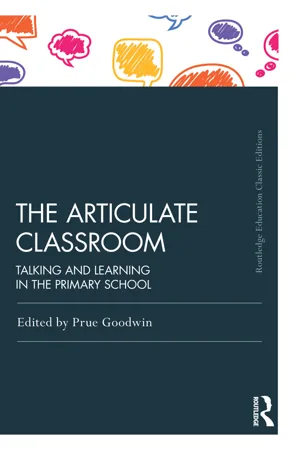
- 180 pages
- English
- ePUB (mobile friendly)
- Available on iOS & Android
About this book
This is a classic edition of Prue Goodwin's acclaimed collection of articles by leading educationalists on the place of talk in the primary curriculum, which now includes a preface from Lyn Dawes. A talking classroom is both a crucial part of every subject area and a subject in its own right. For all primary teachers committed to deepening their understanding of the pivotal role talk plays in learning, this book focuses attention on the importance of fully enabling pupils' learning potential.
Articles, grouped according to a flexible framework, explore:
- the importance of talk in learning
- discursive and interactive classrooms
- talking and learning in the early years
- talk across the curriculum
- the importance of storytelling and drama.
The new introduction reflects on key research developments since the book was first published.
The Articulate Classroom is an engaging introduction to the field which is still very relevant to today's readers. It will remain an indispensable guide for teachers looking to extend their skills, and a unique chance for education researchers to gain an overview from experts in the field.
Frequently asked questions
- Essential is ideal for learners and professionals who enjoy exploring a wide range of subjects. Access the Essential Library with 800,000+ trusted titles and best-sellers across business, personal growth, and the humanities. Includes unlimited reading time and Standard Read Aloud voice.
- Complete: Perfect for advanced learners and researchers needing full, unrestricted access. Unlock 1.4M+ books across hundreds of subjects, including academic and specialized titles. The Complete Plan also includes advanced features like Premium Read Aloud and Research Assistant.
Please note we cannot support devices running on iOS 13 and Android 7 or earlier. Learn more about using the app.
Information
PART 1
Every voice is valued
1
THE ARTICULATE PLAYGROUND
The scraps of lore which children learn from each other are at once more real, more immediately serviceable, and more vastly entertaining than anything which they learn from grownups.(Opie, I. and P. 1959, p. 1)
For the most part teachers fail to capitalise on the wealth of material informally learned by children within the traditional culture of the playground...(Widdowson 2000)
‘Not in front of the grown-ups’ – jokes and traditional games
why these games have a stage on the playground and not in the classroom or home, or not at least when teacher or mum can hear...Adults do not always appreciate the subversiveness of these songs; they have grown up and forgotten them and the pleasure and excitement of singing them. Children enjoy being caught singing these songs, just as a reminder to those adults within earshot that they understand and are capable of understanding more about life than adults think they do.(Tracy Lee, Luton school, 2000)
Football
virtually all played football throughout their playtime. During the game most of the talk could be split into two categories which were either instruction, like ‘kick the ball’ or criticism, ‘why do you always shoot, can’t you pass the ball for a change?’ Both categories of interaction involved short sentences and even shorter responses. The four boys who talked most, held high status positions within the group and were all good footballers. They adopted the role of unofficial captains and vice-captains between them. They had the football skills to dominate the game which made it easier for them to dominate the other boys who lacked their confidence.(Tom Bush, March 2000)
the verbal communication on the pitch was loud. The boys shouted short comments to each other. … However, the game also required the involvement of cooperative skills in order to function effectively.
S: Rivaldo B: What Rinaldo? S: No, Rivaldo, you ponce B: I say Rinaldo, he’s right quick with his feet and pings the ball G: I say Carno J: Gininio, or Zola, ‘And he’s taking the ball down the field, and he’s tackled, will he make it … yes, he scores. It’s a goal!’ (Lara Smith, March 2000)
Girls on the edge
The game involves all players placing a Go-Go (a small plastic figure) on the floor in front of a wall. Players take it in turns to throw another Go-Go to try and knock one over … the game is very popular with both boys and girls, but is always played in single sex groups.(Louise Bundy, March 2000)
involves the use of exclusive language with expressions such as ‘down the line’ and other specialist vocabulary … vernacular language, including swearing was also evident. … The boys often play football in role and ‘become’ Michael Owen or Alan Shearer, changing to Tony Adams or Sol Campbell if they are defending. This sometimes follows current ‘real life’ events. On one occasion, one boy scored a goal and claimed to be Robbie Fowler. He was then informed that it couldn’t have been Fowler because he was injured.(Louise Bundy, March 2000)
‘We wanted to play Pokemon’
‘We wanted to play Pokemon, but we’re not allowed the cards anymore so we have to pretend.’(Year 3 boy)
Child A: Well there’s the cartoon you can watch, there are the cards … but we’re not allowed them any more. Jane: Tell me more about the cards then. Child B: You collect them and play games with them. You try and beat each other … with the powers on the card. On the cards are different Pokemon like Picachu, Beedrill and Bulbasaur. If they have more po...
Table of contents
- Cover
- Half Title
- Title Page
- Copyright Page
- Table of Contents
- Contributors
- Preface
- Acknowledgements
- Introduction
- Part 1 Every voice is valued
- Part 2 Across the whole curriculum
- Part 3 Imagination and creativity
- Part 4 Talking about language
- Index